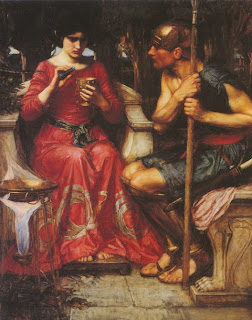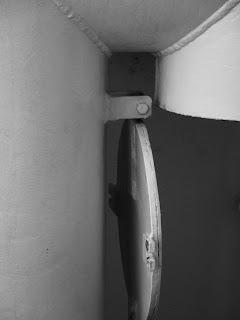At the beginning of the 19th century, Christmas was not widely celebrated, but by the end of Queen Victoria's reign it had become more like the holiday we are so fond of today. The royal family itself are the ones we have most to thank for the introduction of Christmas to Britain. In 1848 (the same year of the formation of our beloved PRB) the Illustrated London News published a drawing of the royal family around a Christmas tree, which Prince Albert had introduced from Germany. Soon nearly every home contained a decorated tree, complete with ribbons, candles, sweets and homemade decorations. Apparently Victoria and Albert decorated their tree themselves, and the children hung gingerbread on the branches - what a lovely idea! Wish I had thought of putting gingerbread on my tree before I swamped it with baubles...
What an evenly decorated tree! though with that many candles it looks to be somewhat of a fire hazard...
In 1843 a design for a Christmas card was commissioned by Henry Cole. There were 1,000 copies and each had to be hand coloured. The card sold for one shilling each - this was more than the average person could pay. However, with the advancement in printing technology, the Christmas card became extremely popular - in 1880 alone 1.5 million cards were produced.
Another commercial aspect to Christmas was invented, again, in 1848 when British confectioner, Tom Smith, came up with a novel and festive way to sell sweets. Inspired by a trip to Paris where he saw sugared almonds sold in twists of paper, he invented the first Christmas crackers. these were at first filled with sweets, then later in the century the contents were changed to paper hats, small gifts and bad jokes.
Ice skating, a popular Victorian past time. That gentleman looks like a very good ice skater! He also looks rather like the other man in the background, and the others too - did the painter run out of models, perhaps?
While searching for Victorian winter paintings, I came across these two beautiful landscapes by Pissarro and Monet. I was interested to see that both works were painted in the same winter; looking it up I discovered that the winter of 1879-80 was particularly harsh, apparently the seventh worst on record. France was bitterly cold - a temperature of -25.6C was recorded in Paris and the Seine was frozen over. Only by February 1880 did the cold finally fade away, almost two years later, for the cold weather started in '78.
I love the different shades of blue in Pissarro's painting, really shows the frozen ground and air - makes me shiver even to look at it! The pastel colours of Monet's painting are beautiful, which contrast between the bright orange of the setting sun and its reflection, and the dark shadowy skeletons of trees. I always love finding new paintings - its so interesting not just to study the paintings themselves, but also look into the history around when they were produced. There are so many amazing things in the past. Oh, the beauty of art history!
Merry Christmas!
Ice skating, a popular Victorian past time. That gentleman looks like a very good ice skater! He also looks rather like the other man in the background, and the others too - did the painter run out of models, perhaps?
Camille Pissarro 1879
Claude Monet 1880
While searching for Victorian winter paintings, I came across these two beautiful landscapes by Pissarro and Monet. I was interested to see that both works were painted in the same winter; looking it up I discovered that the winter of 1879-80 was particularly harsh, apparently the seventh worst on record. France was bitterly cold - a temperature of -25.6C was recorded in Paris and the Seine was frozen over. Only by February 1880 did the cold finally fade away, almost two years later, for the cold weather started in '78.
I love the different shades of blue in Pissarro's painting, really shows the frozen ground and air - makes me shiver even to look at it! The pastel colours of Monet's painting are beautiful, which contrast between the bright orange of the setting sun and its reflection, and the dark shadowy skeletons of trees. I always love finding new paintings - its so interesting not just to study the paintings themselves, but also look into the history around when they were produced. There are so many amazing things in the past. Oh, the beauty of art history!
Merry Christmas!





















































